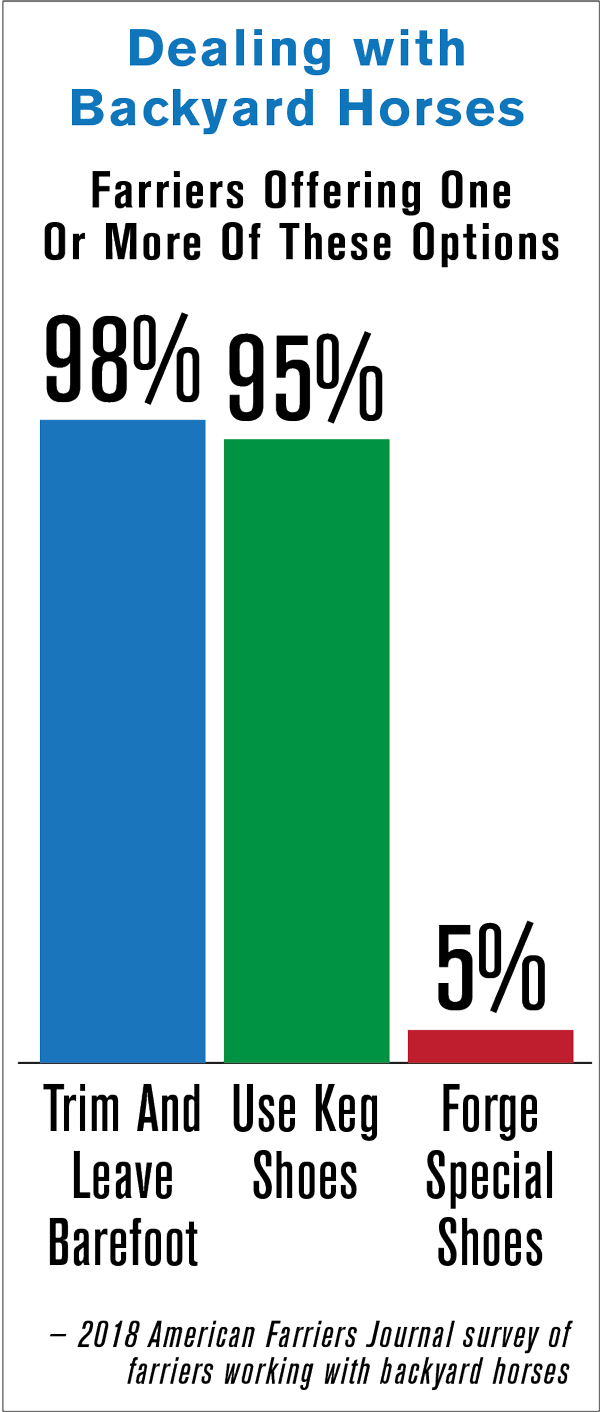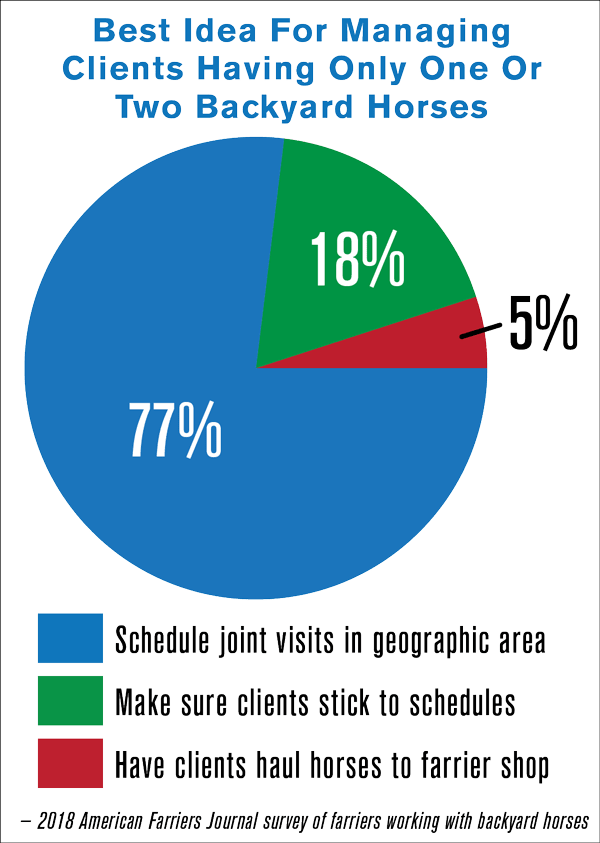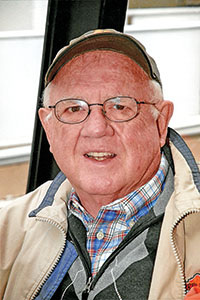Since most farriers have a number of loyal backyard horse customers, it’s not always easy to separate friendships from simply providing footcare work. In fact, many of the 203 farriers who answered a recent American Farriers Journal electronic survey on working with backyard horses indicated they take precautions to avoid becoming close friends with hoof-care clients.
Most of these farriers do not socialize with clients outside of work, preferring to think of horse owners as clients first and friends second.
Dustin Carroll finds it’s important to charge friends the same prices as all clients and treat them in the same way. Over time, they’ll understand you’re doing equine footcare work as a living and can only be friends after the hoof-care work is done, says the Placerville, Calif., farrier.
Farrier Takeaways
- Set boundaries when doing footcare work for friends, always treating them the same as other clients.
- It’s not a farrier’s role to subsidize a client’s horse hobby.
- Know when it’s time to turn over a complicated footcare case to a more qualified farrier or veterinarian.
Gerry Rayon agrees with this approach. “I keep my client relationships professional, and don’t spend time with clients outside of my duties as their farrier,” says the Elma, Wash., farrier. “I’m personable and friendly, but am not considered to be a buddy in the good old boys club.’’
Christine Abramo says her rule is to avoid socializing with clients. Ask yourself if you could maintain the friendship if they started using another farrier, says the Wooster, Ohio, farrier.
Respect Boundaries
No matter how friendly you become with a client, Daisy Bicking says you have to look at footcare work totally as a professional business relationship. In fact, the Parkesburg, Pa., farrier goes out of her way to make sure client friendships don’t get in the way of doing quality footcare work.
It’s not your responsibility to subsidize a client’s hobby …
Chrystina Green says it’s important to treat all clients the same. “If I show up at their house and they are not there, I’ll call and wait 30 minutes to see if they show up or call back. If not, I add a fee for the miles traveled that day to the bill on the next visit,” says the Middletown, Ohio, trimmer.
Kari Hoyer believes in setting client boundaries. “Riding horses with clients and attending weddings, funerals and milestone anniversaries or birthdays is about as far as I’ll take it,” says the Bay City, Wis., farrier.

“It’s still your business,” says Travis Teigen. “If they were really a good friend, they’ll understand why you’re not coming out at 9 p.m. on a Friday night to fix Fluffy’s foot,” adds the Glenwood City, Wis., farrier.
It’s Their Hobby, Not Yours
Paul Skaggs believes it’s not the farrier’s responsibility to subsidize a client’s hobby. “If something takes longer than normal due to therapeutic or other needs, then charge more,” says the Valmeyer, Ill., farrier.
Teigen cautions farriers to avoid being in the business of making a customer’s hobby affordable. If you’re taking extra time to explain something, make sure you get paid for your efforts.
Abramo will point out a horse’s health issues to clients and suggest the owner contact a vet, dentist or chiropractor. “But I don’t treat these issues, don’t get paid for my opinions and will not subsidize their hobby,” she adds.
Handling Complicated Hoof-Care
There are times when a specific footcare situation needs to be passed along to a more qualified farrier or veterinarian. So how do you make this decision based on your limitations, expertise, comfort level and relationship with a client?
Hoyer handles these situations by stating that farriers don’t practice veterinary medicine. Shelbyville, Ky., farrier Allen Horton adds that developing mutual respect over time with clients normally keeps this from becoming an issue.
Teigen finds clients respect you more when you tell them you’re not comfortable doing something and want to call in a more qualified farrier. He finds it’s essential to know your strengths and weaknesses. Skaggs says it’s better to get someone more qualified involved on a case than to tackle something you’re incapable of handling. If you’re honest with yourself and your capabilities, he believes you’ll know when this decision needs to be made.
Ken Norman discusses these situations with the horse owner. “I’ve often gotten an opinion from another farrier or even had another one shoe a problem horse for a period of time,” says the West Pawlet, Vt., farrier. “It shows the owner I’m not afraid to do what’s best for the horse.”

Anytime a horse appears to need drugs, stitches, radiographs, ultrasound, blood work or other diagnostic needs, Rayon says it’s time to call the vet.
Whenever there’s an injury, the horse needs a vet, maintains Abramo. If the horse has ongoing footcare issues that don’t improve, she suggests calling a vet, especially if you have already sought assistance and advice from other farriers. John Muldoon gets a vet involved at the first sign of lameness. The Tuttle, Okla., farrier finds this speeds up the recovery process.
Diane Saunders finds it’s important to not let your ego get involved in making a good decision. “When it’s something I don’t feel comfortable with attempting, I don’t allow my ego to get in the way,” says the Bristol, Vt., farrier.
She refuses to administer vaccines, de-worm or deal with any problem that doesn’t pertain to the outside of the hoof. If a horse needs to be tranquilized for footcare work, she insists that a vet do it.
With all health concerns above the hoof, call the vet …
Steve Mathews allows a maximum of 90 minutes for trimming and shoeing. Additional time is billed on a per-hour basis unless it’s a corrective or therapeutic case, says the Farmington, N.M., farrier. When asked for his observations regarding health issues, he has the client talk with their vet.
LEARN MORE
For More On Backyard Shoeing …
- “There’s Good Money To Be Made Working With Backyard Horses” looks at the economics of this segment of the overall footcare market.
- Texas farrier John Bradshaw shares his thoughts and those of three other farriers in “Backyard Shoeing: Backbone Of A Shoeing Career.”
You can download these articles by visiting
americanfarriers.com/1118
Dane Goede says getting a vet involved depends on the client, horse and situation. At the first sign of an issue with some clients, the Three Forks, Mont., farrier asks them to call the vet. With other clients, he may work with or without the vet on a particular situation.
When clients ask for help with general equine health concerns, Heidi Larrabee tries to be as respectful as possible. The Palmer, Alaska, farrier lets them know the state’s veterinary practice laws tie her hands when it comes to dealing with certain concerns.
With all health concerns occurring above the hoof, Shannon Cole urges clients to call the vet. The McKinney, Texas, farrier says her clients understand and follow this rule.
On the other hand, Green says passing a horse along to a vet isn’t always practical. She cites instances where clients can’t afford a vet.
Rayon says anything more invasive than an abscess needs to be handled by a veterinarian. “However, many horse owners won’t call a vet except as a last resort,” he says. “When that’s the case, I do the best I can for the horse.”








Post a comment
Report Abusive Comment